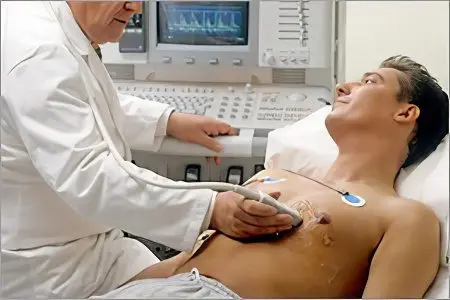Contents
What is cardiac asthma?
Cardiac asthma is a condition of acute failure of the left side of the heart, which is characterized by attacks of shortness of breath, suffocation and requires emergency medical attention, since even the precursors of asthma can be fatal. Insufficiency is expressed in the feeling of lack of oxygen, in connection with which the person begins to cough, wheeze, his face becomes cyanotic, diastolic pressure increases, and fear of death appears. The attack requires the use of urgent measures to help the patient with the intake of nitroglycerin, diuretics, oxygen therapy and other urgent actions.
Cardiac asthma is not an independent disease. This is the name of the clinical syndrome, which is manifested by certain signs. Cardiologists consider cardiac asthma as the most severe manifestation of acute heart failure, which complicates other cardiovascular pathologies that a person has. During an attack, not only the circulatory system suffers, but also the respiratory system. Often, cardiac asthma characterizes the onset of lightning-fast alveolar pulmonary edema, which leads to the death of a person.
Causes of cardiac asthma

The causes of cardiac asthma can be hidden both in the defeat of the heart muscle itself, and in diseases not related to cardiology.
There are the following etiological factors leading to the development of this pathological condition:
Left ventricular failure in the acute stage can lead to the development of cardiac asthma.
Often this clinical syndrome develops against the background of such forms of coronary heart disease as unstable angina and acute myocardial infarction.
Perhaps the development of cardiac asthma in the postinfarction period and against the background of atherosclerotic cardiosclerosis.
Such disorders in the work of the heart as postpartum cardiomyopathy, acute myocarditis can provoke the development of an attack of cardiac asthma. This also includes cardiac aneurysms.
Arterial hypertension with high pressure surges and excessive tone of the left ventricular myocardium, atrial fibrillation, atrial flutter pose a potential threat in terms of the development of this cardiac syndrome.
Provocative factors include heart defects (mitral and aortic), as they impede normal blood flow. Also, blood circulation is disturbed against the background of an existing intra-atrial thrombus, in the presence of a tumor inside the cavity of the heart, which is called myxoma.
Among lung diseases that are the cause of the development of cardiac asthma, pneumonia is distinguished, among kidney diseases – acute glomerulonephritis. Danger in this regard is also represented by any pronounced cerebrovascular accident.
Excessive physical activity, severe emotional shock and stress, hypervolemia against the background of bearing a child, in febrile conditions, with intravenous administration of a large volume of fluid and its retention in the body can provoke an attack.
The danger in terms of developing an attack of cardiac asthma is the excessive consumption of food before bedtime, the same applies to liquids. Against the background of existing heart disorders, asthma can develop even with a quick and abrupt transition from a vertical to a horizontal position.
If we turn to the pathogenesis of cardiac asthma, then it is based on the fact that the left parts of the heart cannot cope with the load placed on them. This leads to the fact that the veins and capillaries of the lungs are filled with too much blood, the hydrostatic pressure in the pulmonary circulation increases sharply. Against the background of excess pressure inside the vessels, plasma seeps through the walls of the capillaries, entering the lung tissue. This leads to the development of interstitial pulmonary edema, which certainly affects their normal ventilation and the process of gas exchange between the blood and the alveoli.
One of the pathogenetic factors of cardiac asthma is an increase in blood flow that fills the vessels, for example, during pregnancy or when the body temperature rises. In this case, the increasing venous blood flow to the heart is accompanied by difficulty in its outflow from the blood-filled lungs to the left heart. That is why it is important for patients with chronic heart failure to avoid physical activity. Provoking cardiac asthma in such patients can also be a horizontal position of the body and intravenous administration of a large volume of fluids.
Disturbances in the nervous system can affect the severity and degree of manifestation of asthma symptoms, since it is she who is responsible for controlling breathing. So, increased heart rate, hyperhidrosis, cold extremities are associated with excessive excitation of the respiratory center.
Symptoms of cardiac asthma
The characteristic symptoms of cardiac asthma begin most often at night. Waking up from suffocation, patients may panic because of the fear of death. In most cases, there is a frequent and rather deep breathing characteristic of the disease with a paroxysmal dry cough. The patient sits up in bed with his legs dangling, or gets up and goes to the open window. Symptoms of cardiac asthma also include pallor of the skin, cyanosis of the face, nasolabial triangle, fingertips, drops of sweat.
When examining a patient, the doctor does not note pathological noises in the lungs during breathing. Only if the symptoms of cardiac asthma are the first harbingers of pulmonary edema, hard breathing is heard, accompanied by moist (finely bubbling) rales in the lower parts of the lungs.
In some patients, cardiac asthma occurs with reflex bronchospasm, which causes dry rales when auscultated. This can cause difficulty for the doctor in making a diagnosis, since similar symptoms are observed in bronchial asthma.
Other symptoms of cardiac asthma include:
On average, 2-3 days before the onset of an attack, the patient may experience symptoms-precursors. There is a feeling of pressure in the chest, shortness of breath, which occurs even with little physical effort.
Attacks manifest more often at night, since during rest the adrenergic regulation weakens, and the blood in a larger volume enters the pulmonary circulation. If the attack begins in the afternoon, then it is most often preceded by nervous or physical tension.
If an attack occurs at night, then the person wakes up abruptly, as he begins to suffocate. Shortness of breath increases, turns into suffocation. At the same time, a dry cough appears. Transparent sputum leaves a little later.
The patient is not able to lie down, as his state of health worsens from this. The person either stands up or sits down in bed with their legs down, which can reduce the severity of shortness of breath. This symptom is called orthopnea (shortness of breath when lying down).
It is difficult for a person to speak, breathing problems are observed.
The patient becomes overly excited, as panic fear of imminent death grows.
The nasolabial triangle and the phalanges of the fingers turn blue. The heartbeat quickens, the pressure rises.
An attack can last for several hours, or it can end in a few minutes. The frequency of exacerbations will depend on the cause that caused cardiac asthma. For example, against the background of mitral stenosis, attacks occur infrequently, since the pulmonary arterioles narrow reflexively, which prevents blood from stagnating in the venous bed and in the capillaries.
If the patient develops right ventricular failure, the asthma may disappear completely.
In some cases, against the background of cardiac asthma, a reflex spasm of the bronchi occurs. This makes the diagnosis of the disease more difficult, since the clinical picture resembles the symptoms of bronchial asthma.
If the attack is protracted and severe, then the nasolabial triangle becomes gray, the patient breaks through cold sweat, the cervical veins increase in volume, filling with blood. The pulse weakens, is practically not palpable, the pressure drops. The person becomes completely exhausted.
The more severe the attack, the higher the risk that alveolar pulmonary edema will join. Its manifestation is indicated by the separation of profuse sputum with foam and blood, severe orthopnea.
Diagnosis of cardiac asthma

Diagnosis of cardiac asthma should be especially thorough, since it is important to distinguish this syndrome from bronchial asthma, from uremia, laryngeal stenosis, hysterical seizure and mediastinal syndrome. The doctor, in addition to a thorough questioning and examination, must study the patient’s history, send him for an ECG and a chest x-ray.
During an attack, it is quite difficult to listen to heart tones, but it is possible to determine their muffledness. Heart rhythm disturbances (gallop rhythm) are also heard, the second tone is accentuated over the pulmonary trunk. The pulse during an attack is weak, sometimes thready. The pressure first rises and then falls. At the same time, single or scattered dry rales are heard in the lungs. There may be single moist rales.
X-ray examination of the chest allows you to determine the presence of signs of venous blood stagnation in the pulmonary circulation, the lung fields will be less transparent, the roots of the lungs are dilated, their necrosis is possible. The presence of interstitial edema will be indicated by the Kerley line.
An electrocardiogram will reveal arrhythmia, coronary insufficiency, a decrease in the amplitude of the teeth.
To make a differential diagnosis with bronchial asthma, it is necessary first of all to pay attention to when the first symptoms of the disease appeared. So, cardiac asthma most often manifests itself in old age. At the same time, the patient does not have an allergic history, there are no diseases of the respiratory system, but there is a cardiovascular pathology.
Emergency first aid for cardiac asthma
Although the attack may go away on its own, there is a high risk of developing pulmonary edema, so emergency first aid for cardiac asthma should be provided to the person on the spot. It is important, as soon as possible, to suppress the excessive activity of the neuroreflex respiratory center, which is in an excited state, to relieve emotional stress, and to increase the outflow of blood from the pulmonary circulation.
Naturally, first of all, you need to call an ambulance, since such a condition poses a direct threat to the life of the patient.
While the doctors have not arrived at the place of the call, maximum peace should be provided to the person. To begin with, he must take a vertical position, for this it is best to put him in a comfortable chair. Legs should be down. If possible, then you need to put the lower limbs in hot water. There should be no objects on the throat and on the body that restrict breathing. To do this, you need to relax the belt, remove the scarf and bandage from the neck, unbutton the collar. Windows should be opened as wide as possible so that fresh air enters the room. If it is not too cold, then the patient can be seated near the window.
Nitroglycerin can relieve the condition. To do this, put 2-3 tablets of the drug under the tongue, or pour 5-6 drops of this drug into the same place. Repeat the intake of Nitroglycerin is allowed after 10 minutes. You can replace Nitroglycerin with one Corinfar tablet. In parallel, you need to control blood pressure. If neither one nor the other means was at hand, then you can replace them with Validol.
Another effective first aid measure for a heart attack is the application of a venous tourniquet. This should be done 10 minutes after the person has taken a vertical position. Nylon tights, elastic bandage, any bandage can replace the tourniquet. The tourniquets are applied to both legs and to the arm. The distance from the inguinal fold to the place where the tourniquet is applied should be 15 cm on the leg, and on the arm – 10 cm from the shoulder. After 15 minutes, the tourniquet is transferred from one hand to the other. Tourniquets are needed so that the blood remains in the limbs, and the load on the heart is less. Thus, the risk of developing interstitial pulmonary edema can be reduced.
Naturally, the sooner a person is hospitalized, the better. This is done even if the attack was stopped. In the future, treatment of the cause that provoked this attack will definitely be required.
Treatment of cardiac asthma

Treatment of cardiac asthma is aimed at stopping the attack as quickly as possible.
Medical assistance is reduced to the following activities:
Taking narcotic analgesics, for example, Morphine or Pantopon. They should be combined with Atropine. The drugs are used to eliminate severe shortness of breath and severe pain.
If there is tachycardia, then the patient should be prescribed Suprastin or Pipolfen.
Against the background of a violation of the respiratory function, in the presence of bronchial spasm, and also if cerebral edema or chronic pulmonary heart is observed, then narcotic analgesics will be replaced with Droperidol.
Allows you to quickly unload the pulmonary circulation against the background of high pressure and venous congestion, such a method as bloodletting. The amount of blood in this case should not exceed 500 ml.
Medical professionals may also apply tourniquets. The time of their exposure on the limbs should not exceed half an hour. It is important that a pulse be felt below the tourniquet.
Oxygen inhalations passed through ethyl alcohol help well. They are carried out using masks or nasal catheters and can reduce swelling of the lung tissue.
Against the background of pulmonary edema, the patient urgently needs to switch to artificial ventilation of the lungs.
To reduce blood pressure, you need to give the patient a diuretic, for example, Lasix or Furosemide, as well as specialized drugs to reduce pressure.
Cardiac glycosides such as Digoxin and Strofantin are almost always administered intravenously during an attack of cardiac asthma.
Eufillin is prescribed for bronchial and cardiac asthma, against the background of mitral stenosis.
Defibrillation is recommended for cardiac arrhythmias.
So, to cure cardiac asthma means to relieve an acute attack and prevent the development of alveolar pulmonary edema. Further therapy is carried out in a hospital and should be aimed at eliminating the underlying disease. Only in this way can an attack be prevented in the future.
As for the prognosis, it is primarily determined by what is the cause of the development of cardiac asthma. It should be noted that in the vast majority of cases, cardiac asthma has a poor prognosis. Although competent treatment of the leading disease and compliance with all doctor’s prescriptions allows a person to maintain working capacity for several years.









